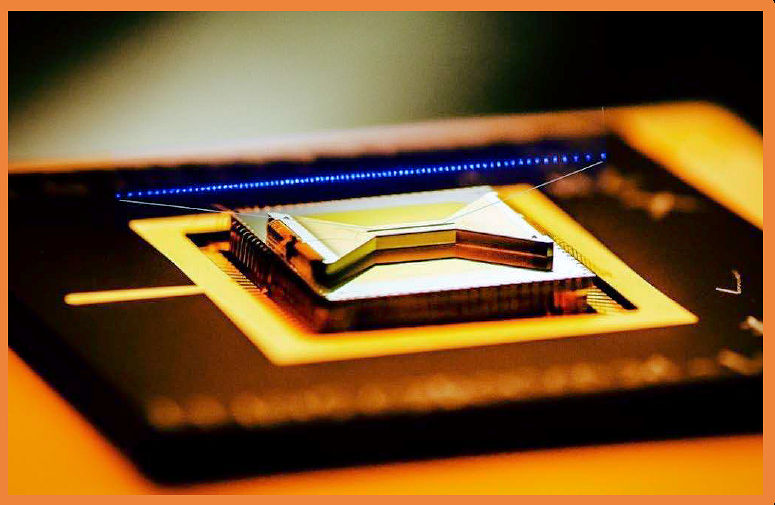I know I’ll be in trouble for saying this, but Professor Christopher Monroe gave a presentation about IonQ’s Quantum computing element at Hot Chips 33, and I very nearly understood it. That does not usually happen when I listen to quantum explanations, which usually end up as a superposition of many understood, poorly understood, and completely misunderstood ideas. I don’t think it’s my fault. Understanding the fundamentals of quantum computing is hard. Implementing a working quantum computer is even harder.
Not Normal
Quantum computers don’t use bits like normal digital computers; they use quantum bits or “qubits.” Not a “cubit.” That’s the measurement system that Noah used to design and build his ark. That system is based on the distance between the elbow and the tip of the middle finger, and it’s supposedly 18 inches or 44 cm, although the particular arm you use to make measurements probably changes the measure significantly. Qubits can simultaneously store zeroes and ones in various proportions. This capability is known as superposition: the values are overlaid in the qubit. Because of this superposition, 300 qubits can store more combinations than there are particles in the universe, so qubits can help us work with large numbers, if we can tame them.
The most obvious use for qubit-based quantum computing is for factoring large numbers. Digital computers are not very good for this application, which is a good thing because modern cryptography depends on the current difficulty in factoring large numbers. The math tells us that quantum computers should be exponentially faster than digital computers when factoring large numbers.
However, quantum computers will be useful for applications well beyond cryptography, including protein folding (for drug research and discovery) and for solving combinational optimization questions such as the traveling salesperson problem, which asks, “What is the shortest path a salesperson can take to visit N cities?” When the number N is small, optimization is fairly easy. When N grows larger, the number of combinations explodes and quickly grows beyond solution by conventional computing.
I’m not about to display my quantum ignorance in this short article. Instead, I’m about to discuss some really interesting developments at Professor Monroe’s company, IonQ. They’re developing a quantum computer. In and of itself, that’s not really big news. Lots of organizations including many universities, Intel, IBM, and Microsoft are developing quantum computers that involve several tons of hardware including cryogenic refrigeration. That’s because most approaches to quantum computing need to chill the circuitry down to near absolute zero to maintain qubit coherency.
Oh darn. Now I have to explain quantum coherency.
Here’s the short version: Qubits can interact with each other. Without interaction, a quantum system can remain in steady state – it maintains coherence. When qubits affect each other, the system they reside in can change state, which results in decoherence. Once the state is lost, you have to start over. Cryogenic temperatures increase the amount of time that most quantum systems can remain coherent.
The only way to do all of this is to use identical parts for each qubit. Wires cannot be made identical; transistors cannot be made identical; Josephson junctions cannot be made identical. So IonQ uses individual ionized rare-earth ytterbium atoms floating inside of an ion trap within a vacuum as qubits. Atoms of the same element (and the same isotope) are identical, so they make great qubits, according to Monroe. According to IonQ’s Website, ytterbium atoms are “so consistent they’re used in one of the most accurate atomic clocks ever built.”
It’s all done with lasers
So how does IonQ deal with coherence? They appear to have sidestepped the problem entirely by basing their qubits on individual atoms. Using atoms (or ions actually), IonQ has developed a system that chills the individual ions to near-absolute-zero levels using Doppler cooling and other laser-based cooling techniques while the apparatus operates at room temperature. The ions cool as they absorb and emit photos. No giant refrigeration unit needed.
The qubit atoms enter an ion trap where they’re manipulated in groups and individually by lasers. A laser strips each ytterbium atom of one electron to create an ion so that the atom can be held in place electromagnetically by a linear ion trap.
Here’s an image of IonQ’s ion trap:

According to IonQ’s Web site:
“It’s impossible to create a trapping force with electrodes at fixed voltages that can hold an ion in a fixed position. Instead, we use rapidly oscillating voltages, such that the average field traps the ions in all three dimensions. As an analogy, imagine placing a ball on top of a saddle, and then spinning the saddle very quickly — it’s the same basic idea.”
The current ion trap design uses about 100 electrodes to hold the ions in place. The electrodes are formed by depositing gold on silicon and etching patterns using conventional lithographic techniques.
It’s all done with lasers
IonQ then uses lasers to put the trapped ytterbium ions in a particular quantum state of superposition, which is stored in each atom’s spin. Once placed in a particular stable quantum state, the atoms can remain in that state for very long periods of time, even at room temperature, as long as they’re held in the ion trap. IonQ also uses lasers to perform operations on the qubits and to read out a final answer. Monroe described these operations as “gates.” For IonQ’s purposes, a gate is one operation on one or more ions. IonQ’s quantum computer performs operations on these ions using an array of individual laser beams, each imaged onto an individual ion, plus one global laser beam that strikes all of the ions in the trap simultaneously. The interference between the individual and global laser beams produces a beat note that provides exactly the necessary energy to kick the qubit ions into a different state.
Once the computations are completed, a resonant global laser illuminates all of the ions at the same time, which collapses any complex quantum information created by the computations and forces each qubit into one of two states. The collapsed state is the calculation result. The ions will glow or not glow when energized, depending on whether they’re in the “one” state or the “zero” state. Collecting and measuring this emitted light allows IonQ to simultaneously read the collapsed state of every ion, and the string of glowing ions is interpreted as the computational result: a binary string, where each glowing atom is a one, and each dark atom is a zero.
Passing a computation through several gates takes place over time, as opposed to a digital circuit design where data flows spatially across a circuit board through a series of gates. According to IonQ’s Website, the company has run single-qubit gates on a 79-ion chain and has complex algorithms on chains of as many as 11 ions. The company is currently working on a system that will operate 32 qubits simultaneously, and the end goal is to produce operational systems compatible with existing data centers by the year 2025. Monroe also commented that IonQ is set to become a public company this year.





